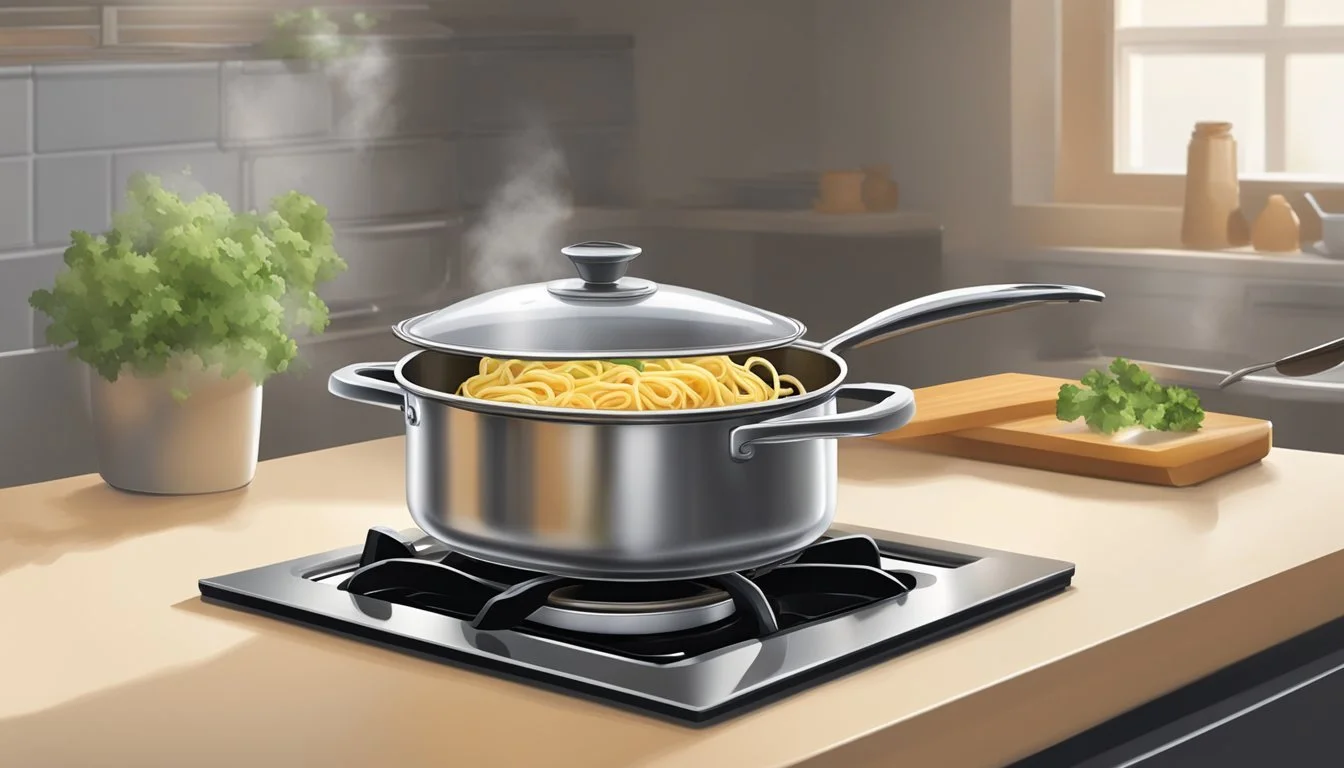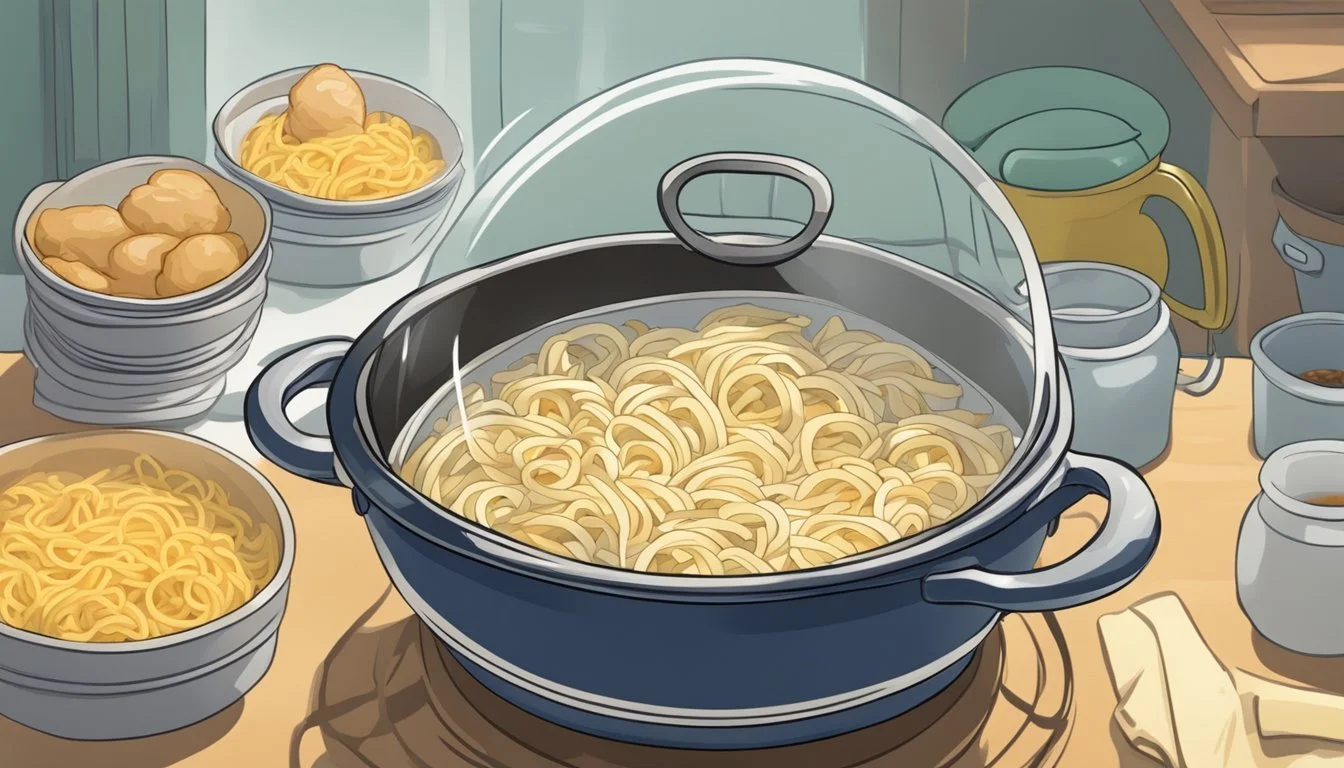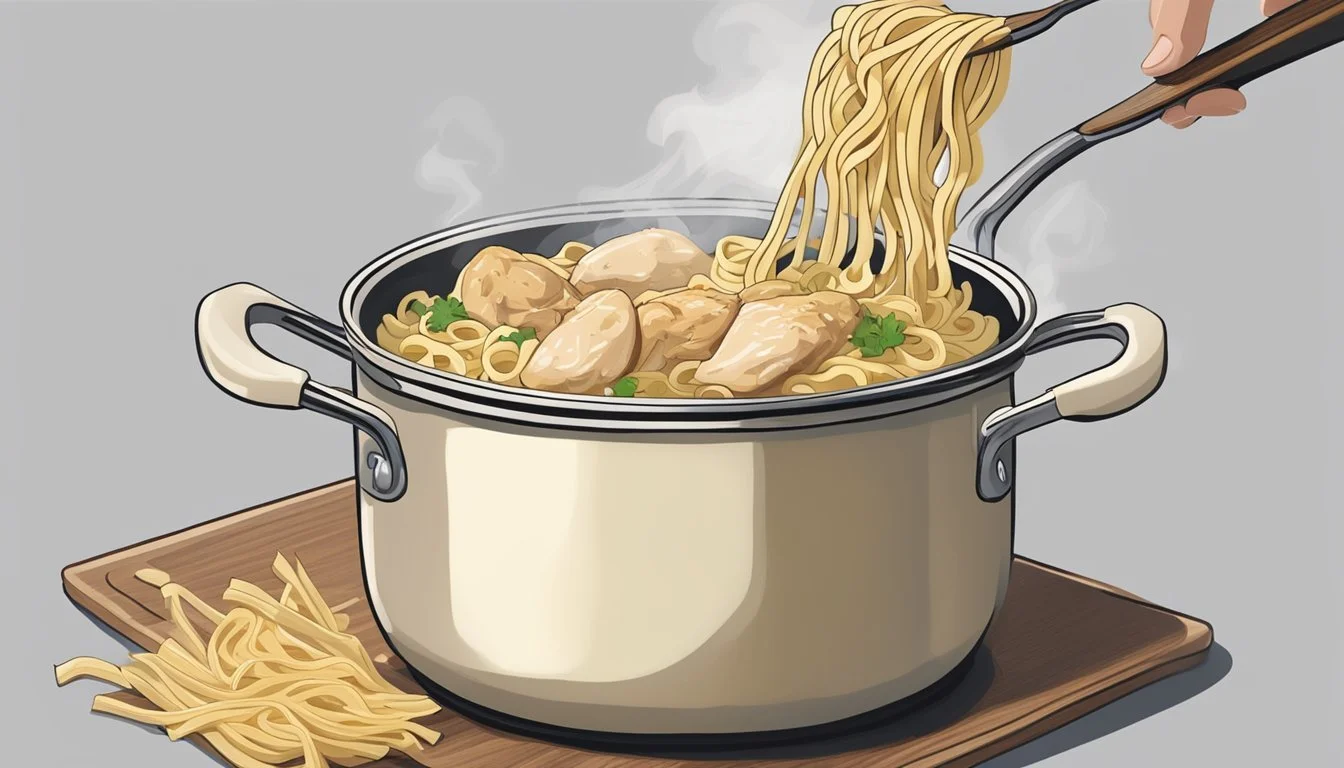Best Way to Reheat Amish Chicken and Noodles
Ensuring Optimal Texture Preservation
Amish chicken and noodles is a classic dish cherished for its comfort and simple, hearty flavors. Finding the best way to reheat this dish without losing the texture of the noodles or the juiciness of the chicken is crucial to enjoying leftovers just as much as the original meal. Overheating can lead to dry chicken and mushy noodles, which significantly detracts from the dish’s appeal.
The key to successfully reheating Amish chicken and noodles lies in gently warming the ingredients while preserving their distinct textures. It is recommended to heat the chicken and broth mixture separately from the noodles to avoid sogginess. The noodles should be brought to just under al dente when initially cooked if they are intended for freezing or reheating.
Reheating should be done carefully, employing methods that reintroduce moisture when necessary and monitoring closely to prevent overcooking. The use of additional broth during the reheating process can help maintain the moisture of the chicken and the firmness of the noodles. While there are several reheating techniques available, some methods stand out for yielding the best results in texture retention and flavor enhancement.
Understanding Amish Chicken and Noodles
Amish Chicken and Noodles is a dish characterized by its hearty flavors and homestyle cooking. It often features simple, fresh ingredients, including homemade egg noodles.
Core Components of Amish Chicken and Noodles
Homemade Egg Noodles: Fundamental to the dish, these are typically made from a mixture of flour, eggs, and salt. The noodles can come in various pasta shapes, though wider, flat noodles are common.
Chicken: The poultry used is often raised by the Amish community itself, ensuring it is fresh. It’s typically boiled and shredded or chopped to mingle with the noodles.
Broth: A flavorful chicken broth, made from cooking the chicken, serves as the base in which the noodles are cooked, absorbing the savory flavors.
Additional Ingredients:
Seasonings: Salt, pepper, and sometimes herbs or spices to taste.
Vegetables: Onions, celery, and carrots might be added for extra flavor and nutrition.
Importance of Proper Reheating
The texture of Amish chicken and noodles can greatly be affected by the reheating process. To maintain their integrity:
Slow and steady: For the best results, reheating on the stove over a low to medium heat allows for even warming without overcooking the noodles.
Microwaving: If using a microwave, it should be done in short intervals, stirring occasionally to distribute the heat and prevent the noodles from becoming too soft.
Each component requires careful reheating to ensure the dish remains as close to its fresh state as possible, thus retaining the comforting qualities it is cherished for.
Pre-Reheating Preparation
Before reheating Amish chicken and noodles, proper storage and preparation of the leftovers ensure the dish maintains its flavor and texture. The key lies in safe food handling and temperature control.
Storage Tips for Chicken and Noodles
Storing Amish chicken and noodles correctly is vital for both safety and quality. One should place the leftovers in an airtight container to preserve freshness and prevent drying out. Refrigeration at temperatures below 40°F is crucial to slow bacterial growth. For best results, follow these guidelines:
Fridge: Store for no more than three days for optimal taste.
Freezer: If freezing, use within one to two months.
Wrapping: When freezing, wrap the container in plastic wrap or aluminum foil for an extra barrier against freezer burn.
Thawing Process for Frozen Leftovers
Thawing Amish chicken and noodles should be done with care to maintain the integrity of the dish:
Refrigerator: Transfer the frozen dish to the refrigerator and let it thaw gradually for several hours or overnight.
Avoid Countertop Thawing: Do not thaw at room temperature since it can lead to unsafe spikes in food temperature, increasing the risk of foodborne illnesses.
By following these pre-reheating steps, one ensures that the Amish chicken and noodles are in the best condition for reheating, which will help in retaining the desired taste and texture of the dish.
Reheating Techniques
When reheating Amish chicken and noodles, it's important to use methods that preserve both the moisture of the chicken and the texture of the noodles. Choosing the right technique and carefully managing the temperature are critical for best results.
Oven Reheating Method
The oven method involves preheating the oven to 350°F (175°C). One should place the chicken and noodles in an oven-safe baking dish, adding a splash of broth for moisture. Covering the dish with foil retains the heat and prevents the chicken from drying out. Heat for about 20-25 minutes or until the internal temperature reaches 165°F (74°C).
Stovetop Reheating Method
For the stovetop, one can opt for a pot or a skillet. Add a small amount of broth to the bottom of the pot to avoid sticking and to add moisture. Heat over medium-low heat, stirring the chicken and noodles gently to ensure even warming. The goal is to slowly bring the temperature up to 165°F.
Microwave Reheating Method
In a microwave-safe plate or dish, spread the chicken and noodles evenly. Sprinkle a bit of water or broth on top to keep the dish moist. Cover with a microwave-safe lid or a vented plastic wrap. Reheat on medium power in intervals of 1-2 minutes, stirring between intervals, until the food reaches 165°F.
Alternative Reheating Appliances
Other appliances like the air fryer can also reheat Amish chicken and noodles effectively. For the air fryer, preheat to 350°F and place the food in the basket. Reheat for about 4-6 minutes, shaking the basket halfway through to promote even heating. The Dutch oven is another alternative, which allows for even heat distribution, particularly when reheating on a stovetop.
Preserving Texture and Moisture
Successfully reheating Amish chicken and noodles while maintaining their ideal texture and moisture involves careful heat management and the right addition of ingredients to prevent drying out.
Avoiding Overcooking
To retain the delicacy of Amish chicken, especially if it's boneless and skinless, one must be vigilant not to reheat to the point of overcooking. The best practice is to reheat the chicken to an internal temperature of 165°F. Use a digital thermometer to monitor this. When heating noodles, they should be warmed just until hot to prevent them from turning soggy. Overcooking can result in a texture that is not only undesirable but also can ruin the meal's overall appeal.
Techniques for Moist Chicken and Noodles
Moisture Retention for Chicken:
Oven method: Bake in a preheated oven at 350°F, loosely covered with foil, to promote even heating and retain moisture.
Stovetop method: Warm gently in a skillet with a tablespoon of water or chicken broth, covered, to add moisture without causing sogginess.
Ensuring Sauced Chicken Stays Juicy:
Add a small amount of the original sauce or use a suitable substitute like olive oil or melted butter to keep the chicken from drying out while reheating.
Noodle Reheating:
If noodles are in a sauce, reheat in a saucepan over low-medium heat, adding a splash of water or sauce to keep them from sticking and to ensure even cooking.
For plain noodles, a quick toss in a skillet with butter or olive oil can restore their pleasing texture without the risk of drying out.
In both cases, gentle reheating with attentive stirring or turning can help achieve a moist and palatable result.
Seasoning and Taste Enhancement
When reheating Amish Chicken and Noodles, enhancing the flavor while preserving the dish's original taste profile is essential. The following subsections detail how to elevate the flavor after reheating and suggest complementary side dishes to serve.
Adding Flavor After Reheating
To ensure Amish Chicken and Noodles remain savory after reheating, one may consider a light addition of seasoning. A pinch of salt and pepper can enhance the natural flavors of the dish. For a more pronounced taste, stirring in a small amount of butter or olive oil can reintroduce richness into the noodles and chicken. If the noodles seem dry, a splash of pasta sauce or chicken broth can add both moisture and depth of flavor, without overwhelming the dish's inherent characteristics.
Complementary Side Dishes
Choosing the right side dishes can enhance the reheated Amish Chicken and Noodles meal by adding variety and balance. A serving of creamy mashed potatoes offers a smooth texture contrast, while their buttery flavor complements the savory notes of the main dish. For those seeking freshness, a simple salad dressed with olive oil and a touch of salt can provide a crisp counterpoint. Alternatively, Amish macaroni salad introduces a tangy and creamy element that pairs well with the chicken and noodles, achieving a harmonious and satisfying meal experience.
Food Safety Considerations
Ensuring that Amish chicken and noodles are reheated safely is critical to maintaining food safety. One must pay close attention to proper temperatures and methods to prevent bacterial growth, especially when dealing with leftovers.
Safe Reheating Temperatures
When reheating Amish chicken and noodles, it is imperative that the dish reaches an internal temperature of 165°F. This temperature ensures that any potentially harmful bacteria present in the leftovers are destroyed. One can use a food thermometer to check the temperature. It is recommended to stir the chicken and noodles during reheating to ensure even distribution of heat.
Preventing Bacterial Growth
To minimize the risk of bacterial growth:
Do not leave the Amish chicken and noodles at room temperature for more than 2 hours.
Store leftovers promptly in the refrigerator at 40°F or below.
When reheating, if using chicken broth, ensure it is heated to a simmering point along with the chicken to aid in achieving the safe temperature throughout.
Always cover the dish to retain moisture and heat more evenly.
Final Serving Suggestions
Once the Amish chicken and noodles are carefully reheated to ensure the texture and moisture are preserved, the final step is to serve the dish in a manner that appeals to both the eye and the palate.
Plating and Presentation
For plating, one should lay a portion of the noodles as the base, ensuring they retain the sauce and highlight the home-style essence of the dish. Resting the chicken atop the noodles showcases the component that gives the dish its name. Recipe developers suggest garnishing with a sprinkling of fresh herbs as a simple yet visually appealing touch that does not detract from the classic simplicity of this pasta dish.
Plate: Spoon a generous portion of noodles onto the plate.
Position: Place the chicken central to the noodle bed.
Garnish: A light sprinkle of parsley or thyme can enhance visual appeal.
Pairings with Amish Chicken and Noodles
While the dish is hearty on its own, the pairings can complement the flavors and add variety to the meal. A side of steamed green vegetables like green beans or broccoli balances the richness of the noodles and provides a vibrant color contrast. For those preferring a hint of acidity, a simple salad with a vinaigrette dressing cuts through the dish's savory notes. When recommending pairings, the sauce's compatibility with the rest of the meal is a key consideration.
Vegetables: Bright, steamed greens or a crisp salad.
Bread: Freshly baked dinner rolls to mop up any leftover sauce.
Beverage: A light white wine or apple cider complements the dish without overpowering it.
Clean-Up and Storage Post-Reheating
After enjoying a warm dish of Amish chicken and noodles, proper storage and cleanup ensure the leftovers remain fresh and flavorful for future meals.
Storing Leftovers
Leftover Amish chicken and noodles should be stored in an airtight container to preserve taste and prevent contamination. It is crucial to cool the dish to room temperature before storage to avoid raising the fridge's internal temperature. The leftovers should promptly be placed in the refrigerator within two hours of cooking to mitigate bacterial growth. Using aluminum foil or plastic wrap can provide an extra seal if an airtight container is not available.
Reheating Tips for Subsequent Uses
When one decides to reheat the stored Amish chicken and noodles, they should aim for even heating to maintain the dish's texture. It is advisable to add a small amount of chicken broth or water before reheating to keep the noodles moist. Covering the dish with a microwave-safe lid or a layer of plastic wrap with some holes poked in it can help steam the noodles evenly. When using an oven to reheat, covering the dish with aluminum foil ensures the noodles do not dry out. Leftovers should reach an internal temperature of 165°F to be deemed safe for consumption.
Frequently Asked Questions
When reheating Amish chicken and noodles, food safety and maintaining the dish’s texture are paramount. It's important to understand the nuances of reheating and food storage to ensure the dish stays delicious and safe to consume.
Can You Reheat Chicken and Noodles Multiple Times?
One should ideally avoid reheating chicken and noodles multiple times. Each reheating cycle can increase the risk of foodborne illness and impact the dish's quality. Food safety experts advise that leftovers should only be reheated once. If one must reheat multiple times, they should ensure that the food reaches an internal temperature of 165°F every time to kill harmful bacteria.
Best Practices for Reheating Deep-Frozen Dishes
When dealing with deep-frozen Amish chicken and noodles, a methodical approach is essential to retain texture and flavor. Before reheating, one should ideally thaw the dish in the refrigerator to maintain a consistent temperature. To reheat:
Oven Method:
Preheat to 350°F.
Place the dish in an oven-safe container.
Cover with foil to keep the moisture in.
Heat until it reaches 165°F internally — typically about 20 minutes.
Stovetop Method:
Place the dish in a skillet with a splash of water or chicken broth.
Cover with a lid and set heat to medium-low.
Stir occasionally and heat until it reaches 165°F.
Thawing before reheating and ensuring an even, safe internal temperature is crucial for both quality and safety.
Expert Insights
This segment draws from seasoned food professionals to ensure that reheated Amish chicken and noodles maintain their deliciously tender and moist flavor, alongside the desired crunchy texture.
Contribution by a Recipe Developer
A recipe developer asserts that the key to reheating any poultry is to retain moisture. For Amish chicken and noodles, he recommends a two-part approach. Initially, chicken should be reheated slowly, covered, at a moderate oven temperature of 350°F. Adding a splash of chicken stock also prevents drying. For noodles, reheating them in a pot on the stove with a bit of butter helps maintain their texture without becoming mushy.
Professional Chefs’ Recommended Methods
Professional chefs emphasize gentle reheating to preserve the dish's integrity. They suggest:
For chicken:
Temperature: 350°F (175°C)
Method: Cover with foil
Duration: 15-20 minutes
Final Check: Internal temperature of 165°F (74°C)
For noodles:
Method: Stovetop in a saucepan
Key Additive: A pat of butter or a spoonful of the original sauce
Stirring: Regularly, to distribute heat evenly
By following these expert tips, one can achieve flavorful and suitably textured leftovers.
Conclusion
Reheating Amish Chicken and Noodles effectively ensures that the dish retains its comforting textures and flavors. One should consider the following steps for optimal results:
Stovetop Method: Gently reheat on a medium-low setting, adding a small amount of chicken broth to prevent dryness.
Microwave Method: Use a lower power setting and cover the dish, stirring periodically for even distribution of heat.
Oven Method: Cover the dish with foil and reheat at a moderate temperature to avoid drying out the noodles.
Key Tips:
Moisture: Adding liquid is crucial to avoid a dry or stiff texture.
Temperature: Heat to a safe internal temperature without overcooking.
Stirring: Regular stirring helps evenly distribute heat and maintain noodle integrity.
It's important to heat the dish just until it's warmed through to preserve its quality. Adhering to these methods will ensure that Amish Chicken and Noodles remain a delightful experience upon reheating.








